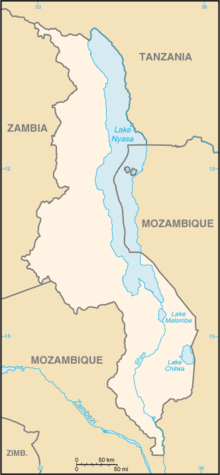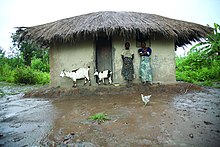
The economy of Malawi is $7.522 billion by gross domestic product as of 2019, and is predominantly agricultural, with about 80% of the population living in rural areas. The landlocked country in south central Africa ranks among the world's least developed countries. In 2017, agriculture accounted for about one-third of GDP and about 80% of export revenue. The economy depends on substantial inflows of economic assistance from the IMF, the World Bank, and individual donor nations. The government faces strong challenges: to spur exports, to improve educational and health facilities, to face up to environmental problems of deforestation and erosion, and to deal with the problem of HIV/AIDS in Africa. Malawi is a least developed country according to United Nations.
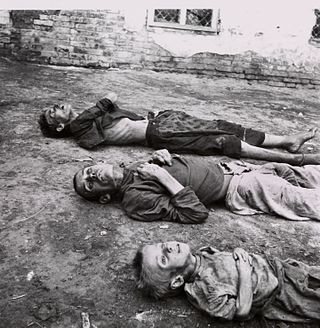
A famine is a widespread scarcity of food, caused by several possible factors, including war, natural disasters, crop failure, widespread poverty, an economic catastrophe or government policies. This phenomenon is usually accompanied or followed by regional malnutrition, starvation, epidemic, and increased mortality. Every inhabited continent in the world has experienced a period of famine throughout history. During the 19th and 20th century, Southeast and South Asia, as well as Eastern and Central Europe, suffered the greatest number of fatalities. Deaths caused by famine declined sharply beginning in the 1970s, with numbers falling further since 2000. Since 2010, Africa has been the most affected continent in the world by famine.

An agricultural subsidy is a government incentive paid to agribusinesses, agricultural organizations and farms to supplement their income, manage the supply of agricultural commodities, and influence the cost and supply of such commodities.
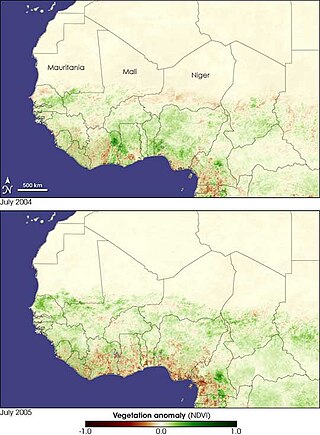
The 2005–2006 Niger food crisis was a severe but localized food security crisis in the regions of northern Maradi, Tahoua, Tillabéri, and Zinder of Niger from 2005 to 2006. It was caused by an early end to the 2004 rains, desert locust damage to some pasture lands, high food prices, and chronic poverty. In the affected area, 2.4 million of 3.6 million people are considered highly vulnerable to food insecurity. An international assessment stated that, of these, over 800,000 face extreme food insecurity and another 800,000 in moderately insecure food situations are in need of aid.
The North Korean famine, also known as the Arduous March or the March of Suffering, was a period of mass starvation together with a general economic crisis from 1994 to 1998 in North Korea. During this time there was an increase in defection from North Korea which peaked towards the end of the famine period.

Farming in North Korea is concentrated in the flatlands of the four west coast provinces, where a longer growing season, level land, adequate rainfall, and good irrigated soil permit the most intensive cultivation of crops. A narrow strip of similarly fertile land runs through the eastern seaboard Hamgyŏng provinces and Kangwŏn Province.
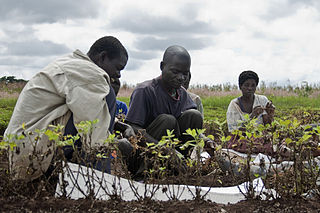
The main economic products of Malawi are tobacco, tea, cotton, groundnuts, sugar and coffee. These have been among the main cash crops for the last century, but tobacco has become increasingly predominant in the last quarter-century, with a production in 2011 of 175,000 tonnes. Over the last century, tea and groundnuts have increased in relative importance while cotton has decreased. The main food crops are maize, cassava, sweet potatoes, sorghum, bananas, rice, and Irish potatoes and cattle, sheep and goats are raised. The main industries deal with agricultural processing of tobacco, tea and sugar and timber products. The industrial production growth rate is estimated at 10% (2009).
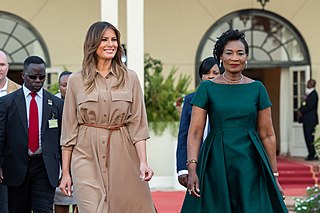
{{Use American English {date=February 2022}}

World food prices increased dramatically in 2007 and the first and second quarter of 2008, creating a global crisis and causing political and economic instability and social unrest in both poor and developed nations. Although the media spotlight focused on the riots that ensued in the face of high prices, the ongoing crisis of food insecurity had been years in the making. Systemic causes for the worldwide increases in food prices continue to be the subject of debate. After peaking in the second quarter of 2008, prices fell dramatically during the late-2000s recession but increased during late 2009 and 2010, reaching new heights in 2011 and 2012 at a level slightly higher than the level reached in 2008. Over the next years, prices fell, reaching a low in March 2016 with the deflated Food and Agriculture Organization (FAO) food price index close to pre-crisis level of 2006.

As of 2012, approximately 1,100,000 people in Malawi are HIV-positive, which represents 10.8% of the country's population. Because the Malawian government was initially slow to respond to the epidemic under the leadership of Hastings Banda (1966–1994), the prevalence of HIV/AIDS increased drastically between 1985, when the disease was first identified in Malawi, and 1993, when HIV prevalence rates were estimated to be as high as 30% among pregnant women. The Malawian food crisis in 2002 resulted, at least in part, from a loss of agricultural productivity due to the prevalence of HIV/AIDS. Various degrees of government involvement under the leadership of Bakili Muluzi (1994–2004) and Bingu wa Mutharika (2004–2012) resulted in a gradual decline in HIV prevalence, and, in 2003, many people living in Malawi gained access to antiretroviral therapy. Condoms have become more widely available to the public through non-governmental organizations, and more Malawians are taking advantage of HIV testing services.
Tobacco production in Malawi is one of the nation's largest sources of income. As of 2005, Malawi was the twelfth-largest producer of tobacco leaves and the 7th largest global supporter of tobacco leaves. As of 2010, Malawi was the world's leading producer of burley leaf tobacco. With the decline of tobacco farms in the West, interest in Malawi's low-grade, high-nicotine tobacco has increased. Today, Malawian tobacco is found in blends of nearly every cigarette smoked in industrialized nations including the popular and ubiquitous Camel and Marlboro brands. It is the world's most tobacco dependent economy. In 2013 Malawi produced about 133,000 tonnes of tobacco leaf, a reduction from a maximum of 208,000 tonnes in 2009 and although annual production was maintained at similar levels in 2014 and 2015, prices fell steadily from 2013 to 2017, in part because of weakening world demand but also because of declining quality.
It is estimated that 64 percent of the Mozambique population is food insecure. The prevalence is higher in the southern region. Mozambique net importer of food. Total annual cereal import requirements average 0.89 million tons. Mozambique must also import substantial quantities of meat and livestock products.
Joe Manduwa is a Malawian politician. He served as a deputy minister and Member of Parliament of Malawi for Mwanza East for the United Democratic Front. He is most remembered for advocating the legalization of chamba, Malawi Gold. He is described as bold, frank, and rogue.
The Agricultural Development and Marketing Corporation, usually known as ADMARC, was formed in Malawi in 1971 as a government-owned corporation or parastatal to promote the Malawian economy by increasing the volume and quality of its agricultural exports, to develop new foreign markets for the consumption of Malawian agricultural produce and to support Malawi's farmers. it was the successor of a number of separate marketing boards of the colonial-era and early post-colonial times, whose functions were as much about controlling African smallholders or generating government revenues as in promoting agricultural development. At its foundation, ADMARC was given the power to finance the economic development of any public or private organisation, agricultural or not.
Food prices refer to the average price level for food across countries, regions and on a global scale. Food prices affect producers and consumers of food. Price levels depend on the food production process, including food marketing and food distribution. Fluctuation in food prices is determined by a number of compounding factors. Geopolitical events, global demand, exchange rates, government policy, diseases and crop yield, energy costs, availability of natural resources for agriculture, food speculation, changes in the use of soil and weather events directly affect food prices. To a certain extent, adverse price trends can be counteracted by food politics.
The International Monetary Fund (IMF) has operated in Malawi since 1965.
The Nyasaland famine of 1949 was a famine that occurred in the Shire Highlands in the Southern Province of Nyasaland and also in a part of the Central Province in 1949: its effects extended into the early part of 1950. The immediate cause was severe droughts in December 1948 to January 1949 and in March 1949 that destroyed much of the maize crop on which the people of the affected areas relied during its main growing season. This followed two years of erratic rainfall and poor harvests which had depleted the reserves in farmers’ granaries. The effect of crop failure was intensified by the failure of the colonial government to maintain a suitably large emergency grain reserve, delays in importing sufficient relief supplies and its requirement that most of the relief provided was paid for by its recipients. The official death toll from starvation was some 200 people, which may be an underestimate, and it excludes those dying of diseases exacerbated by malnutrition.

Chad currently suffers from widespread food insecurity. A majority of the population of Chad now suffers some form of malnutrition. 87% of its population lives below the poverty line. Because the country is arid, landlocked, and prone to droughts, many Chadians struggle to meet their daily nutritional needs. While international aid into the country has brought some relief, the situation in Chad remains severe due to broader famine in the Sahel region. The World Food Programme has declared a state of emergency in the region since early 2018, stating that, “...adding to the poverty, food insecurity and malnutrition which already affects [the nations of the Sahel] to varying degrees, drought, failed harvests and the high prices of staple foods have hastened the arrival of this year’s ‘lean season’ – the worst since 2014.” Malnutrition is high, especially among women and children, with a significant majority of all children in Chad suffering from some form of stunted growth or adverse health effects as a result. As such, health in Chad is greatly affected by lack of food. Food insecurity is a symptom of broader instability in Chad, which suffers from political, ethnic, and religious instability. These issues have contributed to long-term food insecurity in Chad.
During 2022 and 2023 there were food crises in several regions as indicated by rising food prices. In 2022, the world experienced significant food price inflation along with major food shortages in several regions. Sub-Saharan Africa, Iran, Sri Lanka, Sudan and Iraq were most affected. Prices of wheat, maize, oil seeds, bread, pasta, flour, cooking oil, sugar, egg, chickpea and meat increased. Causes included disruption of supply chains due to the COVID–19 pandemic, an energy crisis, the Russian invasion of Ukraine, and significant floods and heatwaves in 2021 which destroyed key crops in the Americas and Europe. Droughts were also a factor; in early 2022, some areas of Spain and Portugal lost 60-80% of their crops due to widespread drought.
Allan Chiyembekeza is a Malawian politician and educator. He was the Minister of Agriculture and Irrigation of Malawi, having been appointed to the position on 12 January 2015 by former president of Malawi, Peter Mutharika. His term began on 31 May 2014. In 2016, he was the Minister of Agriculture, Irrigation and Water Development. As a minister of agriculture, he encouraged local farmers in the country to grow sorghum to deal with the effects of climate change.
